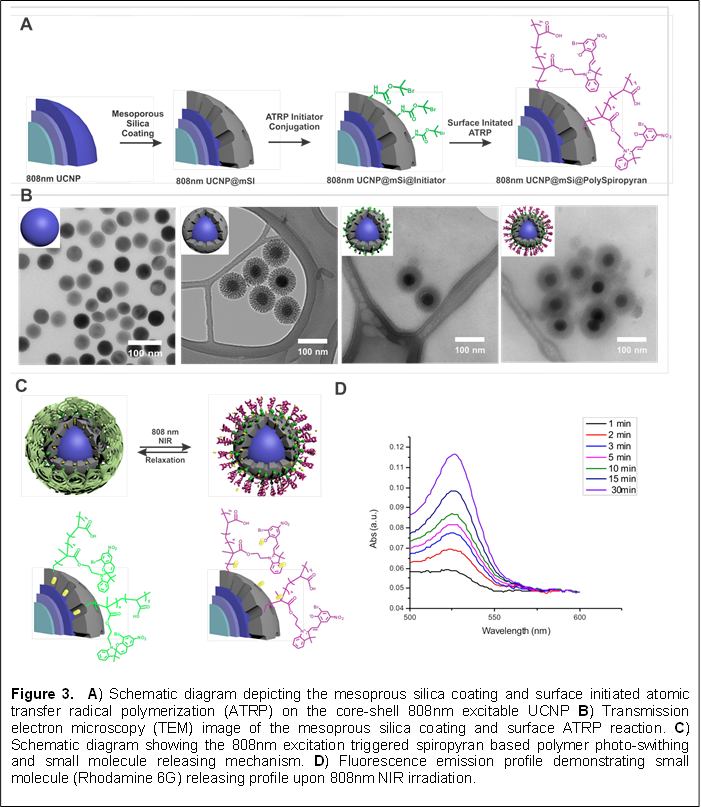Reports: ND1055869-ND10: Photochemical Control of Molecular Optical Switches Using Multicolor Upconversion Nanoclusters
Ki-Bum Lee, PhD, Rutgers, the State University of New Jersey
Narrative Progress Report
The main goal of this ASC PRF project was to develop a multicolor upconversion nanoparticle (UCNP) platform, capable of orthogonally respond to 808 nm and 980 nm excitation wavelengths with ultraviolet and visible emissions that can be used to toggle the photo-isomerization reaction of spiropyran. During the 2nd year project period (from Sep 2016 to Aug 2017) we focused on extending the previously demonstrated UCNP-spiropyran platform by designing and synthesizing a new sandwich structured UCNP with 980 nm excitation and a similar new 808 nm excitable UCNP with spiropyran polymer coating to study small molecule releasing mechanism based on hydrophobicity and hydrophilicity switching. Due to the crucial role of photo-switching polymers to generate dynamic platforms, our research progress will be beneficial for studying on surface wettability, fluid transport, charged particle mobility, particle aggregation, and heat transfer, which are of great significance to petroleum researchers, such as oil transportation and oil emulsification.
As we demonstrated previously, lanthanide-based upconversion nanoparticles (UCNPs) were chosen for their remarkable capability of sequentially absorbing multiple photons to generate single high-energy photon in an anti-Stokes fashion. Subsequently, a novel core-shell structured β-NaYF4:Yb@NaYF4:Er@NaYF4:Yb (Yb@Er@Yb sandwich structure) UCNP was designed and synthesized. This Yb@Er@Yb architecture serves to minimize the probability of energy back-transfer from excited state Ln ions (Er3+) to adjacent Yb3+ ions, by spatially separating them into different layers, which significantly enhances the higher order multi-photon emissions from our designed UCNPs. The sandwich structure generates an 8 fold increase over conventional Yb/Er@Yb core@sensitizing shell UCNPs (Figure 1A). As shown in Figure 1B, we performed spatially-resolved step-by-step single particle Electron Energy Loss Spectroscopy (EELS) in single UCNPS to verify that Yb3+ is only detected in the core and second shell of our Yb@Er@Yb multi-shell sandwich structure. In the EELS spectrum of the Yb3+ containing a core, the unique shoulder at 40 eV can be solely ascribed to the 5p to the 5d transition of Yb3+. Accordingly, this peak is only found when the EELS spectrum is taken in the CS and CSS of our Yb@Er@Yb structured UCNPs, regardless of where in that layer the electron probe is scanned. The EELS data also points out the absence of the Yb3+ in the luminescent shell (Figure 1C). This clearly demonstrates our ability to synthesize our described sandwich structured UCNPs. To utilize 808 nm NIR as a light source for the spiropyran based photo-switching reactions, an efficient NIR to the Visible converter is needed. A similar 808nm excitable UCNP with the aforementioned structure is designed. It consists of a core and two layers of shell structure with different functions, i.e., a luminescent core (LC), a photon-absorbing active shell (AS), and an outer inert shell (IS) (Figure 2A). The first layer, AS, not only minimizes non-radiative decay and vibrational deactivation of the activators (Tm3+) in the LC, but also transfers additional absorbed NIR light (sensitizer Nd3+ and Yb3+ in the AS) to the LC. With the addition of the second layer, IS, the emission stability improves significantly. The composition of the LC is made up of Yb3+, Nd3+, and Tm3+ as co-sensitizers and activators respectively. Subsequently, the AS layer was coated onto the LC with a composition of 20% Yb3+, which is reported to be the optimal concentration for better luminescence. As the transmission electron microscope images are shown in Figure 2B, the LC displays ball shape structure with a diameter of 25.3 ± 0.6 nm. With the growth of the AS, the size of the nanoparticles changes to 33.6 ± 0.7 nm. The second shell IS was further deposited onto the LC@AS nanoparticles, causing an increase in size to 36.1±0.9 nm (Figure 2C). The overall scheme for constructing the spiropyran-based polymer coated UCNP system is shown in Figure 3A. As previous literature suggested, the block copolymer of poly (spiropyran-containing methacrylate)-block-poly(acrylate) (PSPMA-b-PAA) by ATRP underwent reversible SP/MC photo-isomerization under the UV and visible light irradiation, which changes the polarity of the block copolymer, resulting in the release of payload inside the mesoporous shell. The as-synthesized UCNPs were coated with a mesoporous silica shell (21 ± 0.7nm) as small molecule carrying moiety surfactant-assistant sol-gel coating method (shown in Figure 3A). To grow the PSPMA-b-PAA block copolymer onto the mesoporous silica shell, a surface initiated atomic transfer radical polymerization (ATRP) was utilized. Specifically, the UCNP@mSi-Br was used as the initiator for the polymerization initiation. By sequentially adding the spiropyran-containing methacrylate (SPMA) and acrylic acid as monomers, the final block copolymer coated UCNP was gained. The detailed morphological features of the nanoparticles before and after modification were determined by TEM (Figure 3B). Specifically, the initiator functionalization and polymer coating could be observed that the mesoporous silica structure became blurred as shown in the TEM images. As a demonstration of the NIR-based photo-switching capability of the constructed polymer hybrid system, Rhodamine 6G was chosen as a model molecule to study the loading and releasing behavior. In our strategy, the block copolymer PSPMA-b-PAA could undergo structural transformation upon 808nm excitable UCNP-excited UV light irradiation, resulting in the copolymer to shift the hydrophilic-hydrophobic balance to be a hydrophilic layer, which opens up the pathway for the loaded small molecule to diffuse (Figure 3C). The actual releasing profile of Rhodamin 6G in the nano-carrier was characterized by the typical emission peak of Rhodamine 6G at 512 nm (Figure 3D).
In summary, we have established an on-demand small molecule delivery system which utilizes 808nm NIR excitation for the stimuli-responsive release. This release mechanism of the nanoparticle-polymer hybrid system is based on our previous work of using near-infrared 808nm excitation to toggle the photo-switching reaction of spiropyran. Further research will focus on the wettability study of characterizing surface coated with this nanoparticle-polymer hybrid system, which is of significance to oil transportation studies.














